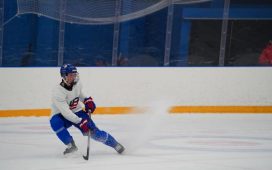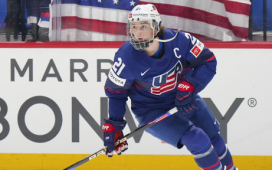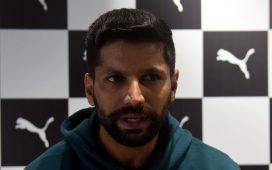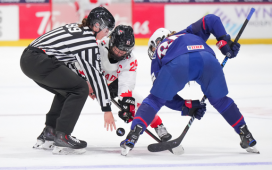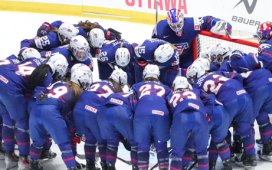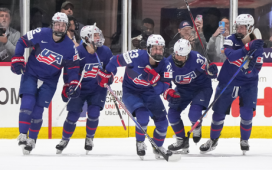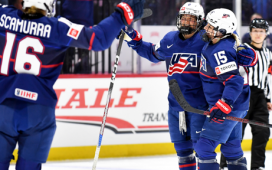With the new CBA on the verge of ratification and the 2019-20 season set to resume in just a few weeks, focus will shift to the 24 teams still alive. That means it’s a good time to complete my season postmortem series for the seven eliminated teams. Last on the list: the New Jersey Devils (28-29-12), who, with the NHL’s 25th-best record, missed the play-in tournament by .07 in points percentage.
It was a highly disappointing result for a team some viewed as mini-breakout candidate after it drafted Jack Hughes first overall, traded for blueliner P.K. Subban and left winger Nikita Gusev and signed right winger Wayne Simmonds last summer. By Dec. 3, the Devils had fired coach John Hynes. By Dec. 16, they’d traded star left winger Taylor Hall. By Jan. 12, they’d fired GM Ray Shero. They’ll enter next season with a new full-time GM in Tom Fitzgerald, who will have his interim tag removed, and a new head coach in Lindy Ruff.
So it’s rock bottom for New Jersey after a season in which a million things went unexpectedly sideways. How did the Devils get here, and how do they climb out of this hole?
WHAT WENT WRONG
Can I just write “everything?” We’ll start with New Jersey’s offense, which, on paper, was supposed to be drastically revamped for 2019-20. Foundational forwards Hall, Nico Hischier and Kyle Palmieri were set to get some serious support among the top six. Hughes wasn’t placed in the generational-talent tier by scouts leading up to the 2019 draft, but he was one level below that, expected to make a franchise-altering impact at the level of a John Tavares or, if Hughes maximized his potential, Patrick Kane.
Instead, Hughes went bust like no No. 1 overall pick since Nail Yakupov. Forget the fact Hughes managed just seven goals and 21 points in 61 games. Even if we compare Hughes only to his peers, his year was terrible. Among 17 rookie forwards who played 500 or more minutes at 5-on-5, Hughes was 16th in goals per 60; 16th in points per 60; first in giveaways per 60; and 16th in team Corsi when he was on the ice. The only rookie forward who graded out worse was, oddly enough, Kaapo Kakko, the other “can’t-miss” 2019 prospect, who went second overall.
When Gusev semi-seriously said before the season his goal was to match or exceed Nikita Kucherov’s 128 points of last year, Gusev was obviously setting himself up to fail. While he did warm up as the season progressed, he was a dud in the season’s first leg, managing five goals and 12 points in 24 games by the time Hynes got the axe as coach. What probably deflated the Devils’ balloon the most, however, was Subban’s season, by far the worst of his career. He looked nothing like the two-time first-team all-star who won the 2012-13 Norris Trophy with the Montreal Canadiens and helped the Nashville Predators reach the 2016-17 Stanley Cup final. He managed just seven goals and 18 points in 68 games. The Devils were outscored 54-36 at 5-on-5 with Subban on the ice. On a weak team, that wasn’t entirely his fault, but he had the fifth-worst goal differential among the Devils’ six regular defensemen. Among 197 blueliners who played 500 or more minutes at 5-on-5, Subban had the 20th-highest expected goals-against per 60.
Factoring in that Simmonds was in obvious decline before the Devils threw $5 million at him, New Jersey’s upgrades failed to move the needle, and the team struggled to score. The Devils were 24th in offense, 22nd in shots on goal per game, 21st in power-play efficiency and averaged the third-fewest scoring chances and eighth-fewest high-danger attempts per 60 at 5-on-5.
And it’s not like the Devils balanced things out with lockdown defense. They were among the league’s three worst teams in shot attempts, shots on goal and scoring chances allowed per 60. Only the pitiful Detroit Red Wings and Ottawa Senators allowed more goals. The Devils were overmatched on both sides of the puck, and two of their regular blueliners, Andy Greene and Sami Vatanen, didn’t play for them by season’s end, so Fitzgerald has significant renovations to make.
WHAT WENT RIGHT
The Devils showed a pulse after Alain Nasreddine took over as interim coach. Well, at least some of their players did. They staked out a 19-16-8 record once he took over and were tops in the league on the penalty kill from that point on. During that stretch, however, they were actually a worse team in possession and territorial play, allowing the most scoring chances in the league, but the tremendous play of goaltender Mackenzie Blackwood skewed those numbers and made the Devils look more competitive.
Blackwood’s breakout was the real deal. From Jan. 1 on, he went 9-4-3 with a .926 save percentage. During that stretch, he ranked eighth in the NHL in goals saved above average per 60 in a sample of 45 goalies who logged 500 or more minutes at 5-on-5. Blackwood did so despite averaging the fourth-most shots against, the 13th-most high-danger shots against, the fifth-most rush attempts against and the eighth most rebound attempts against on a per-60 basis over that span. Blackwood stood on his head. If it weren’t such a strong rookie class, he could’ve received some Calder Trophy buzz. I spoke with the Devils’ executive vice-president of hockey ops, a.k.a. the legend Martin Brodeur, a few weeks ago, and he gushed about Blackwood’s performance. Brodeur considers Blackwood a tremendous natural athlete and an extremely hard worker whom players “love to play for.” While Brodeur believes Blackwood has to improve his puckhandling, the Devils may have found their long-term starter between the pipes.
It also wasn’t as bad as it appeared on the surface for Hughes. Among the aforementioned sample of 17 freshman forwards, Hughes was seventh in shots per 60; sixth in individual scoring chances per 60; fourth in individual high-danger chances per 60; fourth in rush attempts per 60; third in rebounds created per 60; and first in takeaways per 60. He also posted by far the lowest 5-on-5 shooting percentage of the group at just 2.38. Given how highly he rated in chance quality, that’s an extremely unlucky number.
Gusev was also a different player after the coaching change, picking up 32 points in 43 games.
TEAM MVP
Blake Coleman would’ve deserved consideration for his career year, but that got him shipped to the Tampa Bay Lightning leading up to the trade deadline. The tremendously consistent Palmieri deserves respect, too, for managing 25 goals in 65 games despite arguably his weakest supporting cast since becoming a Devil. Across five seasons and 363 games with the team, he averages 29.8 goals per 82 games. But Blackwood is the MVP. It was his play that created the impression of a “turnaround” in the season’s second half when the Devils’ still struggled to control the puck-possession flow.
MAJOR MOVES
This was the rare season in which two different GMs made major moves for the same team. The final big trade of Shero’s tenure, which began in 2015, was to sell off Hall. Shero was backed into a corner knowing Hall wouldn’t sign an extension during the season, and Shero thus had no choice but to cash in the rental chip once it was clear New Jersey wouldn’t be making a playoff run this season.
The return that December day: a 2020 conditional first-rounder, a 2021 conditional third-rounder and prospects Nick Merkley, Nate Schnarr and Kevin Bahl. A few months later, our Future Watch panel of active NHL scouts and executives ranked hulking defenseman Bahl 60th overall among drafted prospects and fifth among Devils prospects – while Merkley and Schnarr didn’t even rank in the Devils’ top 10. Their system graded out as fifth overall, so that’s partially a reflection of the depth, but it’s still not ideal.
Fitzgerald continued the teardown during his interim phase. He traded away veterans Simmonds, Vatanen and Greene. Fitzgerald’s key move was sending the ace penalty killer Coleman, who had a year left on his deal, to Tampa for a 2020 first-round pick that could become a 2021 pick (more on that headache later) and prospect power forward Nolan Foote. It was a great first trade for Fitzgerald and likely sparked a degree of confidence that led to New Jersey removing his interim tag.
DRAFT DAY
With phase 1 of the lottery complete, we know where New Jersey’s own pick stands: seventh overall, which is high enough to secure an A-grade prospect in a draft that is really rich in talent among the top 10 picks or so. With two centers to build around, the Devils could really use a goal-scoring winger. Alexander Holtz would fit the bill.
What about the other two 2020 first-round picks, secured in the Hall and Coleman trades? The Coyotes will hold onto their 2020 pick and defer to 2021 if they lose to Nashville in the play-in round and win the lottery. Otherwise, New Jersey will own the 2020 pick. If the Coyotes get knocked out right away and don’t win the lottery, the Devils will pick ninth, 10th or 11th, depending on what happens to Chicago and Montreal, who had lower points percentages.
As for the Tampa pick: well, it originally belonged to Vancouver before becoming part of the J.T. Miller trade last year. If the Canucks win their play-in round against Minnesota, New Jersey receives the first-round pick in 2020. If the Canucks miss the round of 16, New Jersey gets the pick next year.
So, conceivably, the Devils could pick three times in the first round – or just once, depending on which conditions trigger. Fans should cross their fingers on the max number of first-rounders in 2020, as the Devils don’t own a second- or third-round pick for the draft.
PROSPECTS
The Devils’ farm crop grades out in the top five of Future Watch because Hughes and Hischier count as part of the group. The way we see it, teams shouldn’t be punished in the rankings if their players 21 and younger are good enough to reach the NHL. As for the prospects not yet in the NHL, the Devils’ pool is merely decent. Foote grades out No. 1 and ranks 28th overall among individual prospects in our scouting panel. Puck-moving blueliner Ty Smith also cracks the top 50 and has a chance to make the team next season. It’s discouraging to see the speedy Michael McLeod, drafted 12th overall in 2016, ranked ninth among Devils’ prospects and outside the individual top 100, but he might still become a useful NHLer as a bottom-six defensive forward rather than a scoring-line center. Keep an eye on playmaking left winger Janne Kuokkanen, ranked No. 6 in the Devils’ system. He came over in the Vatanen trade.
SALARY-CAP SITUATION
Fitzgerald has a lot of options in his first off-season as GM. Blackwood is the lone RFA who has earned a significant investment. The Devils could commit to him on a long-term deal, but Matt Murray and Jordan Binnington only got pseudo-bridge pacts after winning the Stanley Cup as rookies, so perhaps Blackwood signs a “prove it” deal of two or three years.
Once he’s sorted out, the Devils have potential to make noise during a flat-cap off-season in which they boast more than $26 million in space. They could chase a big ticket UFA – Mike Hoffman, for instance, would be a really nice finisher to play with Hughes. The Devils could also use their cap space to help desperate teams and take on some salary in exchange for draft-pick sweeteners – or simply acquire another expensive big-name player without a ton of term left, like they did with Subban last season, and hope for a better result.
Advanced statistics courtesy of naturalstattrick.com
Want more in-depth features, analysis and an All-Access pass to the latest content?Subscribe to The Hockey News magazine.
